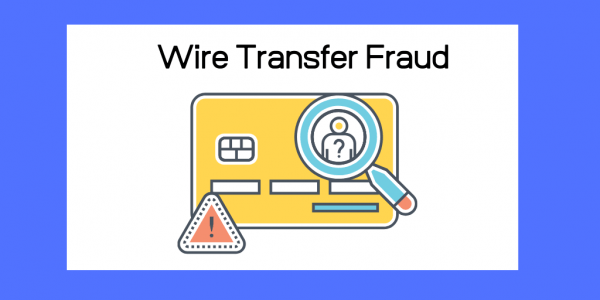Millions of Canadians and Americans have lined up for the jab and states and provinces are beginning to roll out a return to daily life. We’re throwing away those filthy masks and coming out of our homes after months of isolation to get some sun on our faces, and try to figure out how to be social again. For awhile there, it started to look like we’d never see the end of it, but we’re nearly through.
But COVID-19’s left a nasty legacy. It’s not the divisive nature of our politics, or the fact that you’ve discovered your Uncle Jake is a tinfoil hat wearing anti-vaxxer (although that doesn’t help), it’s that scammers have found ways to turn the situation to their benefit. In this case, it’s wire fraud. It was a problem before, as According to the FBI there were $19 million in losses for 2016, and by 2017, that number would swell to $963 million in wire fraud attempts.
Add four years and a pandemic where Skip the Dishes and UberEats have become regular mainstays, and fear of the disease (and distrust of the government and media) have run amok. It’s a fertile breeding ground for criminals, who can take advantage of the knowledge gap and fear.
Here are a few examples of common scams:
- Familiar senders offering information on vaccines via email or text message
- Private companies offering treatments or COVID-19 test kits
- Cleaning companies providing COVID-19 sanitation services or ‘air filters’
- Charities offering ‘free’ PPE
- Local utility companies threatening to disconnect services
- The World Health Organization (WHO) providing lists of infected people in your community
- Financial advisors offering lucrative investment opportunities
- Government agencies requesting personal or health information
That’s more on a personal and retail level, but there is a fair amount of overlap at the institutional level.
For companies where large amounts of money is expected to change hands, wire fraud carries an especially high level of risk. That’s why Identillect Technologies (ID.V) announced that it would be expanding its use of Trusted Blockchain Technology ahead of the rollout of Ethereum 2.0 to continue fighting wire fraud.
The company uses its Trusted Blockchain setup to test the integrity of every level of communication like mitigating the risk of security breaches presently effecting companies using wire transfers. We’ll get to what this means for Ethereum 2.0 in a second.
Wire fraud, like any other type of technologically mediated crime, goes through periods of call and answer. Criminals get a new tactic and it has some measure of success for awhile, and then banks and other officials find a way to defend against it, after which criminals adapt to make their money. In terms of Real Estate and other industries where large sums regularly move, escrow officers have started making regular confirmation calls to ensure that wire instructions are valid prior to completion.
The counter for this is the phone-porting scam, wherein some tech savvy con-artist spoofs your phone number and inserts themselves into the communication chain. Have you ever gotten a phonecall from an obvious scammer, but when you call them back you get a nice little old lady from Coquitlam who has no idea what you’re talking about? Yeah. Her phone’s been spoofed. So when this happens in Real Estate terms, it’s the officer calling the imposter and asking them to verify identity.
Blockchain could fix all that. Instead of calling for verification, the security only allows a wire transfer to be seen if the information is verified by the sender and confirmed through the blockchain at the receiving end. If there’s a compromise, the communication-chain is broken and the sending and https://e4njohordzs.exactdn.com/wp-content/uploads/2021/10/tnw8sVO3j-2.pngistration get a communication indicating where the compromise happened so they can get on it.
What’s this mean for Ethereum 2.0?
Ethereum is going through some changes. The core three problems with said blockchain and the decentralized programming ecosystem it houses were that it’s energy intensive due to its use of the proof-of-work consensus mechanism; it requires a space upgrade to account for more users; and it can’t close the block fast enough, effectively bogging down the whole process. The upgrade to ETH 2.0 is meant to change all that.
Its first change was called the Beacon Chain and it was launched in the waning months of 2020. The only real change that the beacon chain brought was the proof-of-stake mechanism, which not all nodes have adopted quite yet, but will reduce the operating costs of miners. It also works as the foundation for other changes expected to come later on this year, and in 2022.
The first of which is called The Merge—wherein Ethereum’s main-net will merge into the beacon chain format—which will effectively end proof-of-work mining for Ethereum and spread the less energy intensive proof-of-stake mining across the network. This is expected to happen later this year.
Lastly, and relevant to our interests, we have sharding.
Sharding is meant to handle the scaling bottlenecks by breaking up the flow of task of verifying the network into bite sized pieces and handing them out to individual verifiers instead of everyone trying to do everything all at once. If it works, it’ll substantially boost Ethereum’s run-rate, and while we should be hesitant to use words like ‘revolutionize’ if we’re being particularly rational about this, it will do just that making Ethereum (and soon, other blockchains) run circles around Mastercard and Visa and other credit cards in terms of transaction speeds.
Identillect plans to take advantage of Ethereum 2.0’s ability to record a larger number of transactions to its blockchain service, and will expand the scope of its efforts to continue to fight wire fraud and other potential data manipulations. More potential entries means more customers to protect. The development will offer more tools for the real-estate community to protect their clients.
—Joseph Morton





